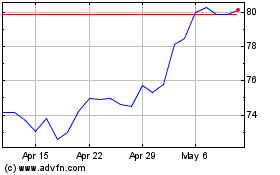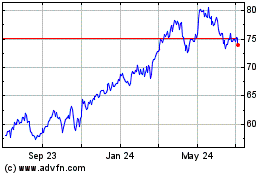AIG: The Value Of Togetherness
February 11 2016 - 3:02AM
Dow Jones News
(FROM THE WALL STREET JOURNAL 2/11/16)
By Steven Russolillo
American International Group Inc. has repeatedly resisted
overtures from investors Carl Icahn and John Paulson to break up
the business. The more that interest rates fall, the better that
AIG's argument looks.
More than a month after the Federal Reserve raised its benchmark
rate from zero, both short- and long-term rates have fallen. Now,
many investors anticipate low rates won't go away anytime soon amid
economic risks and broad market turmoil.
While those conditions tend to hurt large insurers, AIG, for now
at least, has the benefit of diversification on its side. That
should help when it reports fourth-quarter results Thursday.
Analysts expect a loss of 92 cents a share, although that is mainly
due to an announced $3.6 billion reserve charge.
For years, AIG traded at a steeper discount to book value than
many of its peers. That bolstered Mr. Icahn's case for a breakup,
as it suggested AIG isn't reflective of its full value.
But things have changed. AIG shares are down about 15% this
year, which isn't as bad as some other insurance or bank stocks.
And trading at about 10 times projected earnings, AIG commands a
more expensive price/earnings multiple than life-insurance rivals
such as MetLife Inc., Prudential Financial Inc. and Lincoln
National Corp.
In essence, the market is giving AIG a pass that many other
insurers aren't getting. Low rates hurt the profitability of life
insurers, which hold long-term assets to pay future claims. That is
because falling rates inflate the present-value terms of those
claims.
But AIG has a buffer: It also has a property-casualty business
that is less afflicted by low interest rates. And the market is
suggesting that the more-lucrative property-casualty insurance
business is, in effect, subsidizing the life business.
In a strategy update last month, AIG laid out plans to
reorganize its core operations into nine units, part of an effort
to increase transparency. AIG also committed to returning at least
$25 billion to shareholders over the next two years through
buybacks and dividends.
In this tough market for financials, an undivided AIG offers a
bit of hope.
(END) Dow Jones Newswires
February 11, 2016 02:47 ET (07:47 GMT)
Copyright (c) 2016 Dow Jones & Company, Inc.
American (NYSE:AIG)
Historical Stock Chart
From Mar 2024 to Apr 2024

American (NYSE:AIG)
Historical Stock Chart
From Apr 2023 to Apr 2024
